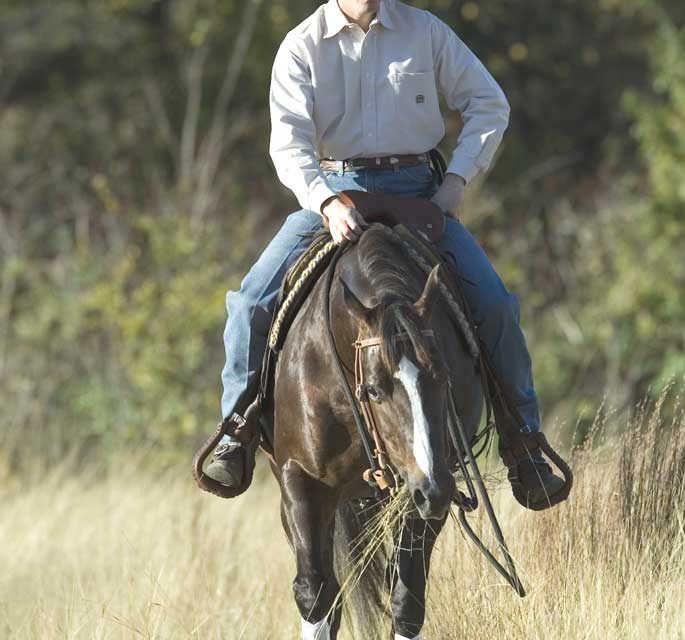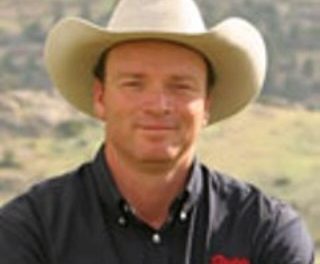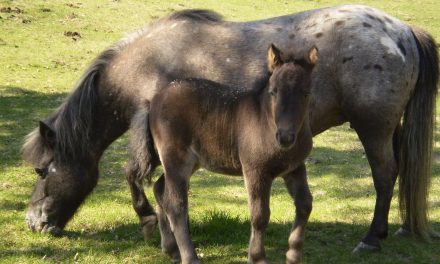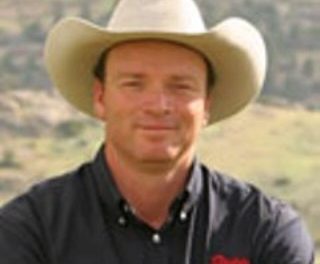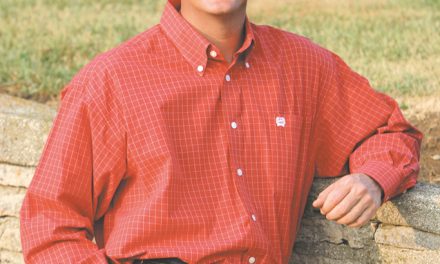How many times have you been out on the trail and either you, or someone you ride with, lets his horse munch on a mouthful of grass to pacify the horse? One problem with this snacking is that a horse can only think about one thing at a time. He’s either got his attention on you or on his next snack. So, he doesn’t always pay attention to where his feet are going and can trip, stumble, and fall over things. This can lead to injury for both the horse and the rider. Also, eating on the trail is a habit that just gets worse and worse if it isn’t corrected.
Become a better leader
Most owners who have horses that snatch at grass along the trail don’t have enough control of their horses. Since the horse is free to do as he pleases, he stays busy eying up his next snack. You just have to be a better leader for the horse and give him some direction. All horses want to have a leader, but you have to be competent and worthy of the job–and you can bet your horse will test you daily. Horses are nothing more than professional people trainers.
What does it take to be a leader for your horse? First, you have to earn his respect and trust. To earn a horse’s respect and trust, you have to move his feet forwards, backwards, left and right and reward the slightest try. Horses don’t want to follow wimps or barbarians. Wimps are people who beg their horses to do things. “Come on, Precious, you can do it,” they’ll say to their horses. Consequently, their horses are usually disrespectful, push them around, and in general, are just plain belligerent. Barbarians are at the other end of the scale. They’re too forceful and aggressive. These are the guys who rough up their horses, and as a result, their horses are fearful and inconsistent.
You want to be right in the middle between wimps and barbarians. You’ll need to be able to seesaw between the two sides, depending on the situation. Sometimes you have to be a little softer to get your point across, and sometimes you have to be a little firmer.
Make snacking uncomfortable
I don’t want you to think, “How can I stop my horse from eating on the trail?” Instead, think, “How can I make it uncomfortable for the horse to eat grass?”
For example, if I’m walking down the trail and all of a sudden, my horse grabs a mouthful of grass, I’m going to redirect his feet and make him hustle. It doesn’t really matter how I make the horse’s feet move, as long as I do it with energy. As soon as he snatches the grass, I bend him around in a circle, and I might kick him with my inside leg. I want to wake him up and get his attention back on me. I let the horse know that he doesn’t have time to be eating grass because he’s too busy listening to me and moving his feet. After I’ve made my point, I put him back on a loose rein and dare him to take another bite.
Ride on a loose rein
It’s important to ride on a loose rein and let the horse make a mistake. If he wants to take a mouthful of grass, let him. I like to explain it to people like this. You can’t arrest somebody for standing outside of a bank with a gun. You have to wait until he goes into the bank with the gun. Then you can arrest him. That doesn’t mean you wait so long that he shoots two or three people. You just wait for the horse to chomp at the grass, and then hustle those feet.
This doesn’t work if you first let the horse eat for four to five minutes, and then barely get him to move. If you let him drag his feet, he’ll be too busy chewing on the grass and dreaming about fairies to pay any attention to you. If he grabs the grass, make him hustle his feet like his life depends on it. Lope him in a circle, gallop him in a straight line, it doesn’t really matter what you do, but get some energy to it. The worst punishment you can give a horse is to make him work. Most horses that eat on the trail are the fatter, lazier horses and this will work well with them.
Squeeze, cluck, and spank
Some horses get so disrespectful that they just stop at a big pile of grass and won’t move even though the rider is kicking and kicking. Remember this: squeeze, cluck, and spank. Squeeze the horse with the calves of your legs to get him to move. If he ignores your squeezing, cluck to him with your tongue. If he still isn’t moving, spank him with the end of your reins or a dressage whip.
1) Squeeze is politely asking the horse to go
2) Cluck is warning him that the spank is going to come
3) Spank is doing whatever it takes to get the horse’s feet to move
You may have to really get after him if he’s being disrespectful. You don’t want to start out whaling on him, but you don’t want to nag him either. Be as easy as possible, but as firm as necessary.
Make the wrong thing difficult and the right thing easy
If making the horse move his feet isn’t working, try popping him on the top of the head when he lunges for some grass. I take the end of my reins and tap him firmly enough so that he says, “Oh man, that wasn’t fun.” It’s almost like a big surprise. Every time he opens his mouth, something quickly smacks him on the top of his head. If every time he takes a bite of grass something whacks him on the head, he’ll eventually stop going for the grass because he’ll be thinking that he’s making himself feel uncomfortable. If you don’t want to use the ends of your reins, you can use the open palm of your hand or even a dressage whip.
A Tip to Remember
Don’t let the horse eat grass when you’re in the saddle, even if you’re at a resting spot just relaxing. You don’t want to contradict yourself. One minute you’re telling him he can’t eat grass and the next you’re telling him he’s allowed to eat. If you want to let him eat grass, step off and let him. That way, he won’t associate eating grass with your riding him.
The best piece of advice I can give you is if you know your horse has a habit of eating on the trail, don’t go walking down the trail swapping recipes with a buddy. Get ready for your horse to make the mistake, and then make the correction. You’ll find that if you put the horse’s attention back on you and give him direction, that he’ll stop eating on the trail and become an overall better trail partner.
About the author
Through his widely-popular Downunder Horsemanship program, Clinton Anderson works hard to educate horse owners on how to be safe and effective while enjoying their horses. His training methods are easy to understand and are designed to help horse owners get the results they desire. Clinton holds clinics and can be seen on RFD-TV. This Australian native is a two-time champion of the rigorous Road to the Horse Colt Starting Challenge, which gives trainers just three hours to break an unstarted colt. Learn more about Clinton at www.downunderhorsemanship.com.

